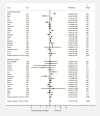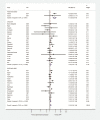Risk of gestational diabetes mellitus in women achieving singleton pregnancy spontaneously or after ART: a systematic review and meta-analysis
- PMID: 32441298
- PMCID: PMC7317285
- DOI: 10.1093/humupd/dmaa011
Risk of gestational diabetes mellitus in women achieving singleton pregnancy spontaneously or after ART: a systematic review and meta-analysis
Abstract
Background: Women who achieve pregnancy by ART show an increased risk of obstetric and perinatal complications compared with those with spontaneous conception (SC).
Objective and rationale: The purpose of this systematic review and meta-analysis was to synthesize the best available evidence regarding the association between ART and gestational diabetes mellitus (GDM) in women with singleton pregnancies. The research question asked was whether the risk of GDM is higher in women achieving singleton pregnancy by ART compared with those achieving singleton pregnancy spontaneously.
Search methods: A literature search, in MEDLINE, Scopus and Cochrane databases, covering the period 1978-2019, was performed aiming to identify studies comparing the risk of GDM in singleton pregnancies after ART versus after SC. Both matched and unmatched studies were considered eligible. Meta-analysis of weighted data was performed using the random effects model. Results were reported as risk ratio (RR) with 95% CI. Heterogeneity was quantified with the I2 index.
Outcomes: The study reports on 63 760 women who achieved a singleton pregnancy after ART (GDM was present in 4776) and 1 870 734 women who achieved a singleton pregnancy spontaneously (GDM in 158 526). Women with singleton pregnancy achieved by ART showed a higher risk of GDM compared with those with singleton pregnancy achieved spontaneously (RR 1.53, 95% CI 1.39-1.69; I2 78.6%, n = 37, 1 893 599 women). The direction or the magnitude of the effect observed did not change in subgroup analysis based on whether the study was matched (n = 17) or unmatched (n = 20) (matched: RR 1.42, 95% CI 1.17-1.72; I2 61.5%-unmatched: RR 1.58, 95% CI 1.40-1.78; I2 84.1%) or whether it was prospective (n = 12) or retrospective (n = 25) (prospective studies: RR 1.52, 95% CI 1.27-1.83, I2 62.2%-retrospective studies: RR 1.53, 95% CI 1.36-1.72, I2 82.5%). Regarding the method of fertilization, a higher risk of GDM after ART versus SC was observed after IVF (n = 7), but not after ICSI (n = 6), (IVF: RR 1.95, 95% CI 1.56-2.44, I2 43.1%-ICSI: RR 1.42, 95% CI 0.94-2.15, I2 73.5%). Moreover, regarding the type of embryo transfer (ET), a higher risk of GDM after ART versus SC was observed after fresh (n = 14) but not after frozen (n = 3) ET (fresh ET: RR 1.38, 95% CI 1.03-1.85, I2 75.4%-frozen ET: RR 0.46, 95% CI 0.10-2.19; I2 73.1%). A higher risk of GDM was observed after ART regardless of whether the eligible studies included patients with polycystic ovary syndrome (RR 1.49, 95% CI 1.33-1.66, I2 75.0%) or not (RR 4.12, 95% CI 2.63-6.45, I2 0%), or whether this information was unclear (RR 1.46, 95% CI 1.22-1.75, I2 77.7%).
Wider implications: The present systematic review and meta-analysis, by analysing 1 893 599 women, showed a higher risk of GDM in women achieving singleton pregnancy by ART compared with those achieving singleton pregnancy spontaneously. This finding highlights the importance of early detection of GDM in women treated by ART that could lead to timely and effective interventions, prior to ART as well as during early pregnancy.
Keywords: ART; IVF/ICSI; embryo transfer; gestational diabetes mellitus; singleton pregnancy; spontaneous conception.
© The Author(s) 2020. Published by Oxford University Press on behalf of the European Society of Human Reproduction and Embryology.
Figures





Similar articles
-
Assisted reproductive technology and hypertensive disorders of pregnancy: systematic review and meta-analyses.BMC Pregnancy Childbirth. 2021 Jun 28;21(1):449. doi: 10.1186/s12884-021-03938-8. BMC Pregnancy Childbirth. 2021. PMID: 34182957 Free PMC article.
-
Obstetric and perinatal outcomes of singleton pregnancies conceived via assisted reproductive technology complicated by gestational diabetes mellitus: a prospective cohort study.BMC Pregnancy Childbirth. 2018 Dec 14;18(1):495. doi: 10.1186/s12884-018-2115-4. BMC Pregnancy Childbirth. 2018. PMID: 30547777 Free PMC article.
-
Obstetric and neonatal outcomes of pregnancies resulting from preimplantation genetic testing: a systematic review and meta-analysis.Hum Reprod Update. 2021 Oct 18;27(6):989-1012. doi: 10.1093/humupd/dmab027. Hum Reprod Update. 2021. PMID: 34473268
-
Risk of gestational diabetes mellitus in patients undergoing assisted reproductive techniques.Eur J Obstet Gynecol Reprod Biol. 2014 May;176:149-52. doi: 10.1016/j.ejogrb.2014.02.009. Epub 2014 Feb 15. Eur J Obstet Gynecol Reprod Biol. 2014. PMID: 24630294
-
Perinatal complications and live-birth outcomes following assisted reproductive technology: a retrospective cohort study.Chin Med J (Engl). 2019 Oct 20;132(20):2408-2416. doi: 10.1097/CM9.0000000000000484. Chin Med J (Engl). 2019. PMID: 31634242 Free PMC article.
Cited by
-
Effect of Gestational Weight Gain during the First Half of Pregnancy on the Incidence of GDM, Results from a Pregnant Cohort in Northern Greece.Nutrients. 2023 Feb 10;15(4):893. doi: 10.3390/nu15040893. Nutrients. 2023. PMID: 36839252 Free PMC article.
-
Obstetric and Perinatal Complications Associated with Assisted Reproductive Techniques - Review.Maedica (Bucur). 2021 Sep;16(3):493-498. doi: 10.26574/maedica.2020.16.3.493. Maedica (Bucur). 2021. PMID: 34925608 Free PMC article.
-
Cohort profile: Anhui Maternal-Child Health Study in China.BMJ Open. 2022 Jun 28;12(6):e060091. doi: 10.1136/bmjopen-2021-060091. BMJ Open. 2022. PMID: 35768099 Free PMC article.
-
Pregnancy-related complications and perinatal outcomes following progesterone supplementation before 20 weeks of pregnancy in spontaneously achieved singleton pregnancies: a systematic review and meta-analysis.Reprod Biol Endocrinol. 2021 Nov 4;19(1):165. doi: 10.1186/s12958-021-00846-6. Reprod Biol Endocrinol. 2021. PMID: 34732210 Free PMC article.
-
Pre-pregnancy LDL/HDL and total Cholesterol/HDL ratios are strong predictors of gestational diabetes mellitus in women undergoing assisted reproductive technologies.Reprod Biol Endocrinol. 2024 Dec 5;22(1):155. doi: 10.1186/s12958-024-01320-9. Reprod Biol Endocrinol. 2024. PMID: 39639281 Free PMC article.
References
-
- Ashrafi M, Gosili R, Hosseini R, Arabipoor A, Ahmadi J, Chehrazi M. Risk of gestational diabetes mellitus in patients undergoing assisted reproductive techniques. Eur J Obstet Gynecol Reprod Biol 2014;176:149–152. - PubMed
-
- Azziz R, Carmina E, Chen Z, Dunaif A, Laven JS, Legro RS, Lizneva D, Natterson-Horowtiz B, Teede HJ, Yildiz BO. Polycystic ovary syndrome. Nat Rev Dis Primers 2016;2:16057. - PubMed
-
- Bahri Khomami M, Boyle JA, Tay CT, Vanky E, Teede HJ, Joham AE, Moran LJ. Polycystic ovary syndrome and adverse pregnancy outcomes: current state of knowledge, challenges and potential implications for practice. Clin Endocrinol (Oxf) 2018;88:761–769. - PubMed
-
- Barros Delgadillo JC, Alvarado Mendez LM, Gorbea Chavez V, Villalobos Acosta S, Sanchez Solis V, Gavino Gavino F. [Perinatal results in pregnancies obtained with embryo transfer in vitro fertilization: a case-control study]. Ginecol Obstet Mex 2006;74:626–639. - PubMed
-
- Beyer DA, Amari F. Maternal risk factors and neonatal outcomes after ART treatment – a German monocenter experience. Middle East Fertil Soc J 2016;21:155–160.

